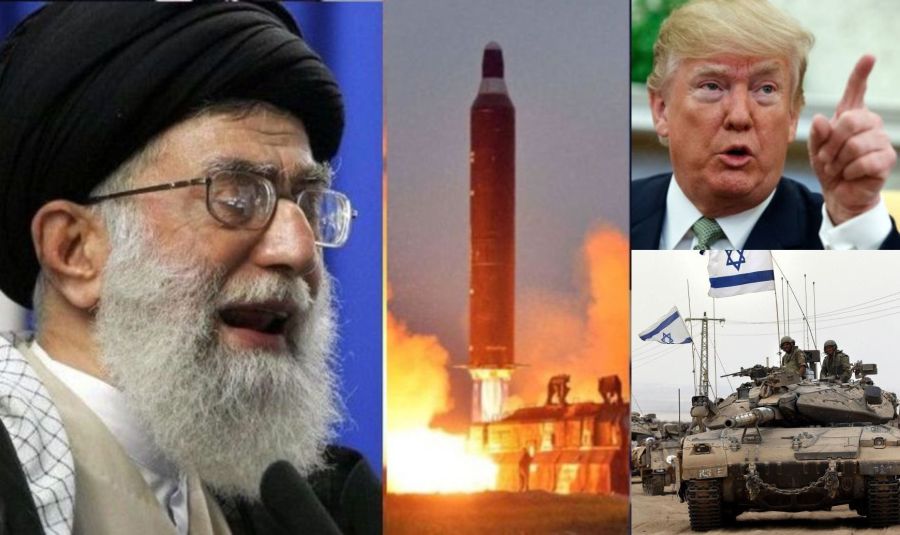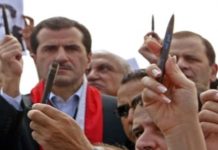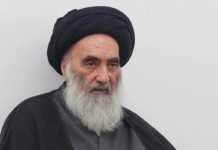صواريخ الملالي تقتل الإيرانيين وتفشل في حماية إيران
أمير طاهري/الشرق الأوسط/15 أيار/2020
Mullahs’ Missiles Kill Iranians but Can’t Defend Iran
Amir Taheri/Asharq Al Awsat/May 15/2020
Last Monday’s tragedy in the Gulf of Oman in which 19 Iranian naval officers were killed and 15 others injured in a “friendly fire” incident has focused attention on the Islamic Republic’s failure to develop a realistic defense doctrine that reflects Iran’s interests as a nation rather than as a vehicle for an ideology.
The exercises during which the tragedy happened was one of several designed to test the Islamic Republic’s ability to engage in naval battles with an unnamed “enemy” and, thanks to several generations of missiles, emerge victorious.
Tehran’s obsessions with missiles started in the 1980s during the war with Iraq in which Saddam Hussein’s army held a monopoly of missile power. Under the Shah, Iran had not shown interest in missiles because it had access to the most advanced warplanes. When he mullahs seized power in 1979, Iran lost that access, and with it the superiority that a modern air force secured. The Iraqis used their Soviet-made Scud (al-Hussein) missiles, along with French Exocets, with little impact in military terms. But the psychological impact on Iran’s new rulers was immense.
To the mullahs, as to the Egyptian leader Abdel Nasser before them, missiles were the weapons of the poor against a rich enemy that could afford expensive warplanes. Abdel Nasser had not made any military gains thanks to his missiles, al-Zafer and al-Qaher, but the propaganda benefits he secured justified investment in them.
According to the memoirs of the late, Hashemi Rafsanjani, a key figure in the first 30 years of the Islamic Republic, the idea of building a missile power-base was first aired in Tehran in mid-1980s under the influence of North Koreans who offered to supply the mullahs with their Rodong ballistic missiles based on an original Chinese model.
Sometime in the mid-1980s, Iran’s new rulers developed a defense doctrine in which missiles featured as a key element in the new regime’s military dispositions. The doctrine was a mixture of North Korean military culture and Ayatollah Ruhollah Khomeini’s (mis-)understanding of early Islamic warfare.
Khomeini wanted the doctrine based on what he called “an army of 20 million”. He imagined a long war, probably against the United States, in which Iran could field millions of “volunteers for martyrdom” and sustain huge casualties while the Americans, whom he believed were “afraid to die”, would fail to do the distance.
According to various accounts both Rafsanjani and the then chief of the Revolutionary Guard Gen. Mohsen Reza’i promoted the idea of transforming the Islamic Republic into a regional “superpower” in terms of missiles.
A third tentative element was added later when Khomeini lifted the ban he had imposed on Iran’s nuclear project that had started under the Shah in 1956 as a scientific and industrial endeavor.
Three decades later, the doctrine in question may be in need of a radical revision. Khomeini’s “army of 20 million” is no more than a fantasy, which Iran’s flattening demographic curve and dire economic problems exclude.
More importantly, perhaps, there is no evidence that as many Iranians today would be “volunteers for martyrdom” as the time the ayatollah developed his nightmarish dream.
The nuclear angle of the triangle may also be redundant as economic pressure, internal discord and, more recently, lack of easy money from oil exports, have turned the pursuit of even tactical nuclear weapons a luxury that the Islamic Republic cannot afford at present.
That leaves the third, missiles, angle to thrive. Missiles are the weapon of the poor especially when copied from foreign models courtesy of North Korea, China and to a lesser extent Russia.
Over the last 30 years, Tehran has developed three generations of missiles, often with little reference to Iran’s actual defense needs. Whenever the North Korean and Chinese wanted to empty their stocks of outdated missiles they found a keen buyer in Tehran with lots of oil money to burn. The Iranian buyers couldn’t care less whether the missiles had been developed for the specific needs of North Korea or China and thus might not address Iran’s own needs.
Today, Iran owns and maintains a wide range of obsolete missiles that may be of archeological interest to students of warfare history. The Nour missiles, based on the Chinese C-802, with a range of 120 kilometers fired from fixed platforms, may be as cute as a cuddly grandmother but useless in modern warfare. Other Chinese and/or North Korean copies, such as Kawthar-1, Qader and Nasr, could be useful if Iran were to fight an equally underdeveloped adversary. Other missiles, for example Ra’ad copied from the Chinese Silkworm may make sense if used by a reasonably advanced navy, like the one China is developing as part of an ambitious plan to make the People’s Republic a member of the “Bluewater” club of nations capable of projecting naval power across the oceans.
A series of cruise missiles, notably Hoveyzeh with a range of 1,350 kilometers, and its more problematic version Ya-Ali would require airborne target-search and pinpointing radar mechanisms that Iran has not yet developed.
Some in the Iranian military seem to be aware of the fundamental flaws of a defense doctrine that ignores Iran’s geopolitical reality as a nation and tries to reflect the interests of an ideology which is, after all, something intangible.
One more problem is Iran’s continued dependence on North Korean and Chinese partners for spare parts, technology, maintenance and training-for-use of virtually all its missiles. There is no guarantee that either Beijing or Pyongyang would want to be dragged into a war that the Islamic Republic might trigger to prolong its existence as an exporter of revolution.
No credible defense doctrine could be shaped without clearly identifying a putative adversary. Yet, pushing aside the propaganda fluff, Tehran’s defense doctrine may be only tangentially related to enmity for Israel and the United States. Both nations helped Iran during the eight-year war against Iraq under Saddam Hussein. Both may find Khomeinism repulsive but neither has an interest in turning Iran as a nation-state into an enemy.
What Iran needs is a national defense doctrine designed to ensure is security as a nation-state and not the current hodgepodge aimed at bolstering a bankrupt ideology’s braggadocio.
The mullahs’ missiles kill Iranians, and passengers of foreign jetliners, but cannot ensure Iran’s national security.
صواريخ الملالي تقتل الإيرانيين وتفشل في حماية إيران
أمير طاهري/الشرق الأوسط/15 أيار/2020
جذبت الحادثة المأساوية التي وقعت الاثنين الماضي في خليج عُمان وأسفرت عن مقتل 19 ضابطاً بالبحرية الإيرانية وإصابة 15 آخرين جراء التعرض لـ«نيران صديقة»، الأنظار إلى إخفاق الجمهورية الإسلامية في تطوير عقيدة دفاعية واقعية تعكس المصالح الإيرانية كأمة وليس كأداة لتطبيق آيديولوجيا.
وكانت التدريبات التي شهدت وقوع الحادثة أحد تدريبات أخرى كثيرة مصممة لاختبار قدرة الجمهورية الإسلامية على الاشتباك في معارك بحرية مع «عدو» لم تحدد هويته، والخروج من الاشتباك منتصرة بفضل أجيال عدة من الصواريخ المتاحة لديها.
كان الولع الإيراني بالصواريخ قد بدأ في ثمانينات القرن الماضي أثناء الحرب مع العراق والتي احتكر خلالها جيش صدام حسين القوة الصاروخية. في ظل حكم الشاه، لم تبدِ إيران اهتماماً بالصواريخ لأنها امتلكت القدرة على الحصول على أكثر الطائرات الحربية تطوراً. وعندما استولى الملالي على حكم البلاد عام 1979، فقدت إيران هذه الميزة، ومعها تفوق القوة الجوية. على الطرف المقابل، استغل العراقيون صواريخ «سكود» السوفياتية الصنع (الحسين)، بجانب صواريخ «إكزوست» الفرنسية، من دون تأثير يذكر من الناحية العسكرية. ومع هذا، جاء التأثير النفسي لتلك الصواريخ على حكام إيران الجدد هائلاً.
من وجهة نظر الملالي، مثلما كان مع الزعيم المصري عبد الناصر من قبلهم، كانت الصواريخ سلاح الفقراء في مواجهة عدو ثري باستطاعته تدبير تكلفة الطائرات الحربية الباهظة. ومع أن عبد الناصر لم يتمكن من تحقيق أي مكاسب عسكرية بفضل صواريخه، «الظافر» و«القاهر»، جاءت المزايا الدعائية التي جلبتها هذه الصواريخ لتبرر الاستثمار فيها.
وتبعاً لمذكرات هاشمي رفسنجاني، إحدى الشخصيات البارزة خلال الأعوام الـ30 الأولى من عمر الجمهورية الإسلامية، ظهرت فكرة بناء قاعدة من القوة الصاروخية في طهران للمرة الأولى في منتصف الثمانينات تحت تأثير الكوريين الشماليين الذين عرضوا على الملالي إمدادهم بصواريخ «رودونغ» الباليستية المعتمدة على نموذج صيني أصلي.
وفي منتصف الثمانينات، طور حكام إيران الجدد عقيدة دفاعية ظهرت فيها الصواريخ عنصراً محورياً في الترتيبات العسكرية للنظام الجديد. وكانت العقيدة الجديدة مزيجاً من الثقافة العسكرية الكورية الشمالية و«سوء» فهم آية الله الخميني للحروب الإسلامية الأولى.
من جانبه، رغب الخميني في صياغة عقيدة تقوم على ما وصفه بـ«جيش الـ20 مليوناً». وتخيل الخميني حرباً طويلة الأجل، ربما في مواجهة الولايات المتحدة، يمكن لإيران خلالها الدفع بملايين «المتطوعين من أجل الشهادة» وتحمّل سقوط أعداد ضخمة من الضحايا بينما سيفشل الأميركيون، الذين اعتقد أنهم «يخشون الموت»، في الإقدام على الأمر ذاته.
وتبعاً لشهادات متنوعة، عمل كل من رفسنجاني وقائد «الحرس الثوري» آنذاك محسن رضائي على الترويج لفكرة تحويل الجمهورية الإسلامية إلى «قوة إقليمية كبرى» فيما يتعلق بالصواريخ.
وفي وقت لاحق أضيف عنصر ثالث عندما رفع الخميني حظراً كان قد فرضه على البرنامج النووي الإيراني الذي بدأ في عهد الشاه عام 1956 مشروعاً علمياً وصناعياً.
وبعد ثلاثة عقود، ربما أصبحت هذه العقيدة في حاجة إلى تنقيح راديكالي. اليوم، أصبح «جيش الـ20 مليوناً» الذي روًج له الخميني مجرد وهم بالنظر إلى تسطح المنحنى الديموغرافي في إيران والمشكلات الاقتصادية الهائلة بالبلاد.
وربما يكون الأهم من ذلك أنه ليس هناك دليل على أن مثل هذا العدد من الإيرانيين اليوم سيكونون «متطوعين من أجل الشهادة» مثلما كان الحال وقت صياغة الخميني لمثل هذا الحلم المريض.
وربما يكون عنصر القوة النووية أصبح زائداً على الحاجة هو الآخر بالنظر إلى الضغوط الاقتصادية المتفاقمة في الفترة الأخيرة والخلافات الداخلية وتراجع عوائد صادرات النفط؛ الأمر الذي جعل من السعي وراء امتلاك ولو مجرد أسلحة نووية تكتيكية رفاهية ليس بمقدور الجمهورية الإسلامية توفيرها في الوقت الحاضر.
ويتركنا ذلك أمام العنصر الأخير: الصواريخ التي تبدو بمثابة سلاح الفقراء، خاصة عندما يجري نسخها من نماذج أجنبية بفضل عروض ودودة من جانب كوريا الشمالية والصين، وبدرجة أقل روسيا.
على مدار الأعوام الـ30 الماضية، طورت طهران ثلاثة أجيال من الصواريخ، غالباً من دون أن يكون لها صلة تذكر بالاحتياجات الدفاعية الإيرانية الفعلية. وفي أي لحظة راودت الكوريين الشماليين أو الصين الرغبة في التخلص من مخزوناتهم من الصواريخ التي عفّى عليها الدهر، كانوا يجدون في إيران مشترياً متحمساً يملك كثيراً من أموال النفط التي يسعى لتبديدها. ولم يأبه المشترون الإيرانيون لحقيقة أن تلك الصواريخ جرى تطويرها من أجل تلبية احتياجات كوريا الشمالية أو الصين على وجه التحديد، وبالتالي ربما لا تلبي احتياجات إيران.
اليوم، تملك إيران مجموعة واسعة من الصواريخ عديمة القيمة التي ربما تقتصر قيمتها على دراستها كأثر لطلاب تاريخ الحروب. على سبيل المثال، نجد أن صواريخ «نور»، القائمة على نموذج صاروخ «سي – 802» الصيني، والتي يبلغ مداها 120 كيلومتراً وتطلق من على منصات ثابتة، ربما تكون في لطف وود الجدة الحنونة، لكنها من دون أدنى قيمة في ظل الحروب الحديثة. وهناك صواريخ أخرى، مثل «الكوثر 1» و«القادر» و«الناصر»، من الممكن أن تكون مفيدة حال خوض حرب في مواجهة عدو على الدرجة ذاتها من التخلف.
وهناك صواريخ أخرى، مثل «الرعد» المنسوخ من صاروخ «سيلكورم» الصيني، قد تبدو منطقية حال استخدامها من جانب قوات بحرية متطورة، مثل القوات الصينية التي تطور تلك الصواريخ في إطار خطة طموح لجعل الجمهورية الشعبية جزءاً من نادي «بحرية المياه الزرقاء»، وهي مجموعة دول قادرة على نشر قوة بحرية عبر المحيطات.
وهناك سلسلة من صواريخ كروز، أبرزها «حفيظة» الذي يبلغ مداه 1350 كيلومتراً، ونسخته الأكثر إثارة للجدل «يا علي»، تتطلب قدرة محمولة جواً للبحث عن الأهداف وآليات رادار دقيقة لم تطورها إيران بعد.
ويبدو أن البعض داخل المؤسسة العسكرية الإيرانية مدرك تلك العيوب الجوهرية في عقيدة دفاعية تتجاهل الواقع الجيوسياسي للبلاد ويحاول أن يعكس مصالح آيديولوجية تبقى في النهاية كياناً غير ملموس.
وتتمثل مشكلة أخرى في استمرار اعتماد إيران على كوريا الشمالية والصين في الحصول على قطع الغيار والتكنولوجيا والصيانة والتدريب على الاستخدام فيما يخص جميع الصواريخ التي تملكها. وليس هناك ما يضمن أن أياً من بكين أو بيونغ يانغ سترغبان في أن تجدا نفسيهما متورطتين في حرب قد تثيرها الجمهورية الإسلامية بسبب رغبتها في إطالة أمد وجودها كمصدر للثورة.
المؤكد أنه من المتعذر بناء عقيدة دفاعية جديرة بالاعتماد عليها من دون تحديد بوضوح العدو المفترض. ومع هذا، فإنه لدى تنحية الجلبة الدعائية جانباً، فإن عقيدة طهران الدفاعية ربما تكون على صلة بصورة عرضية فقط بالعداء مع إسرائيل والولايات المتحدة. جدير بالذكر أن كلا البلدين قدما العون إلى إيران خلال حرب السنوات الثماني في مواجهة العراق تحت قيادة صدام حسين. ورغم أن إسرائيل والولايات المتحدة قد تعتبران الفكر الخميني مقيتاً، لكن أياً منهما ليس لها مصلحة في تحويل إيران كدولة إلى عدو.
إن ما تحتاج إليه إيران عقيدة دفاع وطنية مصممة لضمان أمنها كدولة وليس صورتها الحالية كأداة مصممة لتعزيز آيديولوجيا مفلسة.
والنتيجة أن صواريخ الملالي تقتل الإيرانيين، وطائرات المدنيين الأجانب، لكنها عاجزة عن ضمان الأمن الوطني الإيراني.






















